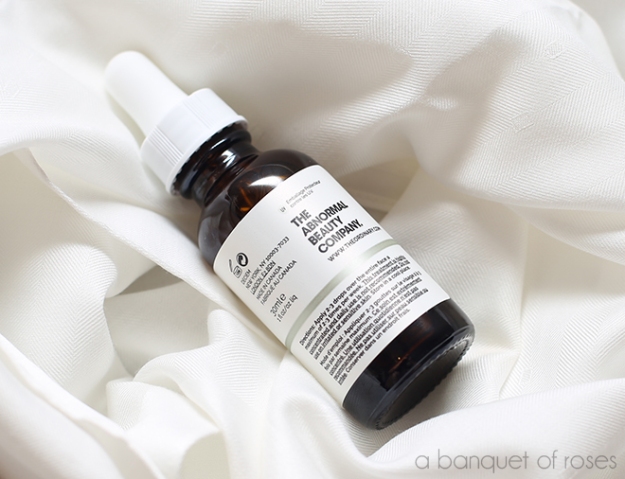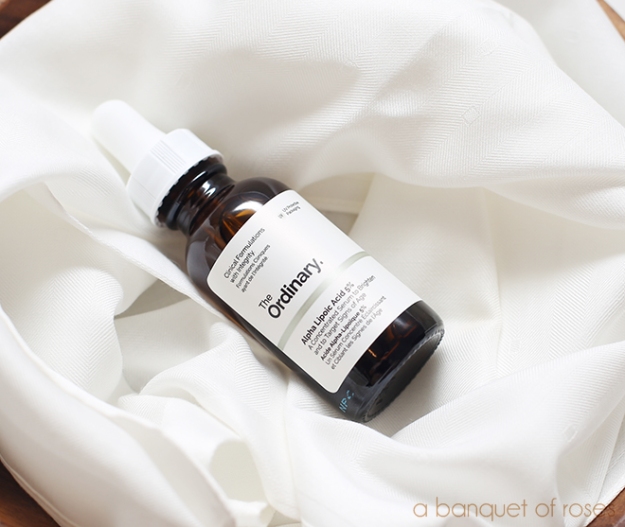Alright, it’s been a while (2 full years)–I am definitely still into skincare, I’m just less into experimenting with new products. So you can imagine how that affects my blogging output–it is a hobby that needs to be sustained with all things new and novel.
I’d love to declare that my days of doing skincare Tinder is over and I am for the most part settling down with my tried and tested arsenal. However, recently I discovered by my favourite product from The Ordinary, Alpha Lipoic Acid 5% has been removed from the Deciem website, and I’m guessing that it has been discontinued. I’m devastated. I have not even had a chance to wax lyrical about the magnificent magic in a bottle. It might be too late to rave and convince you to get this product, so read this more like it’s a eulogy. (;_;)
Just a shot of the LA lounging in my white hankies.
I’ve only ever heard of α-lipoic acid (“LA”) as a dietary supplement for weight loss (I took DHC Alpha Lipoic Acid Diet Supplements back when weight loss was my life goal). It was in amazement that I woke up the very first morning after use and saw how radiant my skin looked in the mirror. The immediate effect beats that of Estee Lauder ANR and Hanyul BHG Cream (Review), my two HGs. I never thought this day would come.
The product and claims
It comes in a dark glass pipette tube. The serum has a slight yellow tinge and smells like burnt latex. Extremely unpleasant scent. I use about two drops and pat in after cleansing and hydrating serum, and man this baby burns. It takes some getting used to and I imagine some might never be able to tolerate the painful formula. I usually follow up with a soothing oil – HABA Squalane (Review) or Marula oil, and a cream to top it off.
The serum claims to “Restore a renewed skin appearance, improving visible skin texture and tone when applied topically.” It really does, especially when used in combination with all of my other big guns. My skin looks great the next morning.
It is also while trying to write this review that I registered how I haven’t really thought about what “aging” means. When something is “anti-wrinkle”, what does that mean? Wrinkle is a symptom of something deeper going on in the body, and what is this something? This brings me to:
What exactly are the signs of aging?
- Thinning of the epidermis
- Decline in level of collagen and glycosaminoglycans (“GAGs”, naturally occurring polysaccharides i.e. carbohydrate)
- Changes in the connective tissue reduce the skin’s strength and elasticity
- Changes in their chemical structure and 3-D organisation
- The skin becomes dryer
- Sebaceous glands produce less oil
- Pigment Spots
- Number of melanocytes decrease, while the remaining melanocytes increase in size. This, combined with the thinning of epidermis makes pigment spots much more visible
- Also a bunch of other factors

See the warning signs there? “This treatment is highly concentrated and daily use is not recommended. Do not use on irritated or sensitive skin.”
What should anti-aging ingredients do?
With the above, we can conclude on the functions a star anti-aging ingredient should serve:
- Thicken epidermis and dermis
- Increase the level of production of collagen, elastin fibres and other connective fibres
- Help the skin retain moisture by supplementing the reduced oil production – This is easy as lots of skin care products contain moisturisers like squalane
- Prevent the increase in size of melanocytes
So, does LA fit the bill?
I had a lot of fun exploring the NCBI (“National Center for Biotechnology Information”) archives for more information on this star ingredient. Rather than simply linking them I thought it’d be fun to summarise some here. There’s something about smoker rats 🙂
Study #1 LA induces collagen biosynthesis (Link)
The study is done by DHC Corporation in Japan, and published on Connective Tissue Research in 2010. I’ve only read the abstract because you’ve got to pay to read the full thing and I’m cheap.
This study finds that LA enhances type I collagen synthesis. It is just a synopsis, so from what I can see this looks like in vitro study only on the human dermal fibroblasts (essentially skin cells – not epidermal cells on the surface, but those deeper layers responsible for generating connective tissues). I got dizzy from reading the synopsis (all the mechanisms and pathways) because it has been years since A’ Level Chemistry or Biology and I could barely remember the basic structure of an amino acid (but thank you Google for the refresher).
Study #2.1 Topical LA is effective in reducing signs of aging (Link)
Published in 2003 in the The British Journal of Dermatology. This study was done on 33 ladies with mean age 54.4 years old, half of the face is treated twice daily with 5% LA cream twice daily for 12 weeks, the other side treated with placebo cream. After evaluation by test subjects, clinical evaluation, photographic evaluation and laser profilometry, there is a statistically significant improvement to signs of aging.
Study #2.2 Topical LA is effective in reducing signs of aging (Link)
I name this study 2.2 since the design isn’t too different from 2.1.
Study is done on 20 ladies of unknown age, half of the face is treated twice daily with 5% ALA gel for 6 months, the other side treated with placebo cream. After evaluation by Global aesthetic improvement scale (“GAIS”) and measuring thickness of epidermis and dermis with ultrasound biomicroscope, there is statistically significant improvement to signs of aging on the side with ALA gel. There is also an increase in skin thickness on the ALA gel side, but the result is not statistically significant.
Study #3 Effect of ALA on smoke-induced skin damage in a bunch of smoker rats (Link)
I don’t think this is topical application of LA, but the idea of smoker rats (!!) is amusing to me so I’m sticking it in.
The study was done on 28 female rats. Eight rats were placed in control group (non-smoking); ten in smoking group with no treatment; the remaining ten placed in smoking with LA treatment group. Smoker rats were exposed to 12 cigarettes a day, and LA treated rats are treated to 100 mg/kg of LA for 8 weeks.
At the end of 8 weeks, skin samples are taken from epigastric area (i.e. tummies) and observed or tested with a series of tests.
- Lipid peroxidation i.e. oxidative degradation of lipids, meaning free radicals run off with elections from the lipids in cell membranes, cell walls are damaged, barrier function impaired
- Significantly higher in cigarette group than in control group (Conclusion: Do not smoke)
- Significantly lower in LA group than cigarette (Conclusion: If you’re a smoker, you can consider injecting / ingesting LA, I don’t know how LA is administered in this study – oral? intravenous?)
- Protein carbonylation i.e. oxidation of the organic R group of amino acids, like proline, arginine and lysine, cell walls are damaged, barrier function impaired
- Higher in cigarette group than the control group but the result is not statistically significant.
- Significantly higher in the LA it was significantly lower compared to the control group and cigarette.
Putting it together
I haven’t been able to find a meta-analysis of LA’s use in cosmetics so there are some inconsistencies. If LA can stimulate production and deposition of Type I collagen (Study #1), why is it that it is inconclusive on the thickening of epidermis and dermis (Study #2.2). Studies 2.1 and 2.2 shows improvements in signs of aging but what are the mechanisms that’s working the magic?
Right now I still have half a bottle left in my stash, but I guess I’m back on the prowl for good antioxidants – we don’t have to be monogamous when it comes to skincare. Alpha Lipoic Acid 5%, thank you, it was fun while it lasted.

